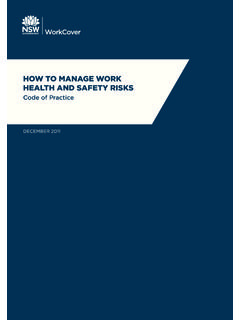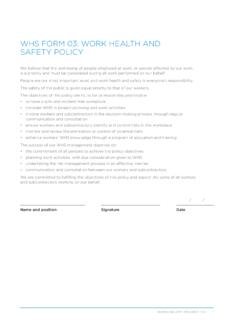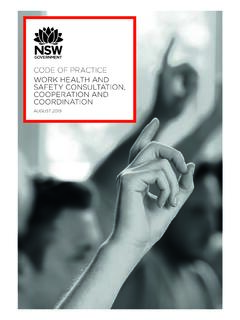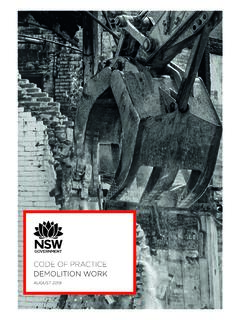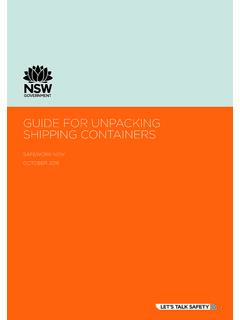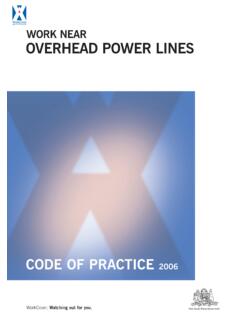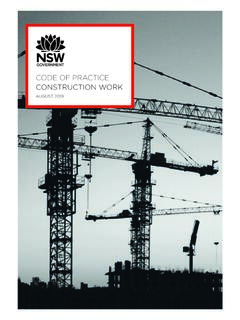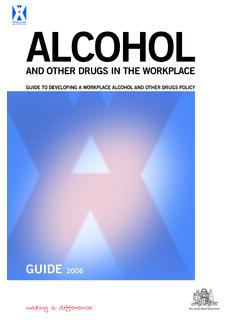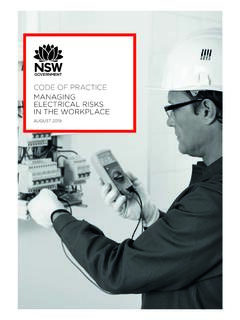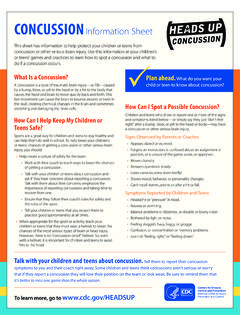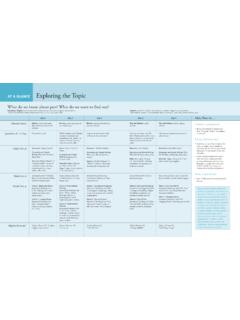Transcription of Forklift Safety Toolbox Talk Guide - SafeWork NSW
1 Forklift Safety . STARTS WITH YOU. Toolbox talks . KEEP FORKLIFTS AND. PEDESTRIANS SEPARATED UR D. YO OA. L. 'T. N. O E. D OS. L. This Guide will help you hold Toolbox talks with HOW TO SUPPORT Safety BEHAVIOUR. your workers about the three main causes of IN YOUR WORKPLACE. Forklift deaths and serious injuries in NSW, To encourage worker Safety behaviour: which are: Talk about Safety hold regular Safety talks , ask 1. People being hit by a Forklift workers for feedback on hazards and safe work 2. People or drivers being hit by the load a Forklift is practices, and when you give work instructions carrying or lifting include Safety advice and directions 3. Drivers being crushed in a tip-over. Reward safe behaviour set Safety goals together, praise your workers when you see them working When it comes to working safely around forklifts, safely, give out a regular safe worker award businesses are responsible for the health and Safety Address unsafe behaviour of workers, contractors, volunteers, and any visitors to Make it visual hang Safety posters, put Safety your site.
2 Guides in the lunch room or toilets, put up a Safety chart to track incidents and near misses We have resources and guides about working safely with forklifts, which can be downloaded free from the Lead by example make sure you always SafeWork NSW website at work safely or by calling 13 10 50. Keep training show your workers how to work safely, remind them of safe work practices, give These three Toolbox talks will help you to start a Safety refresher training at least annually and following an conversation with your workers about forklifts. incident or near miss, enrol them in a course Don't forget about visitors make sure you also talk about Safety with delivery drivers, contractors and other visitors to your workplace. By law you must: Identify and act on any potential hazards Put systems in place for the safe use of forklifts Provide suitable information, training, instruction or supervision to keep workers safe Notify SafeWork NSW of all serious injuries/illnesses and dangerous incidents.
3 1. Toolbox TALK ONE. KEEP FORKLIFTS AND PEOPLE SEPARATED. Include these workers: Forklift drivers and others who work near moving forklifts. Preparation for the talk To prepare for the Toolbox talk: Make sure there are barriers and/or clearly marked pedestrian walkways and Safety zones in the workplace. See SafeWork Australia's Workplace Traffic Management Guidance material for more information Make sure you have internet access ( phone or tablet) to show our Forklift Safety video Have a Forklift (with a load on the forks) in a safe accessible place, making sure it is secure, with the ignition keys removed Have a pen and notebook to jot down any Safety suggestions from workers Print out the SafeWork NSW Take Forking Safety Seriously guides for operators and people who work near forklifts. READ OUT. Fact People are most at risk of being hit by a Forklift if they are: Walking alongside it Picking stock off a nearby shelf Walking in between it and a truck Stepping into its path, or Assisting with loading/unloading.
4 Case Study A large distributor was moving frozen product in the lead up to Christmas. The loading dock was much more crowded than usual, limiting visibility. A worker entered the loading dock to check stock for a pickup later in the afternoon. As he was checking, he had his back turned to the freezer. A Forklift came out of the freezer in reverse and hit the worker, causing serious lower leg injuries. There were clearly marked walkways with barriers throughout most of the workplace; however, the stock could not have been checked from the walkway. The driver was wearing a hoodie and had earphones in listening to music. The Forklift was fitted with a working reversing sensor, but it could not be heard over the sound of the freezers. The Forklift driver said he sounded his horn before reversing and was also looking behind but CCTV footage showed he was looking toward the front of the Forklift . Ask your workers: What could have been done differently?
5 Possible answers: Better staggering of product to prevent forklifts being in the same place as workers Re-schedule work activities so that forklifts are not in operation at the same time as workers checking stock Forklift driver checked over his shoulders Driver should have worn a beanie instead of a hoodie, to enable better vision Used proximity devices for forklifts and people Used pallet jacks instead of forks during busy times Not worn headphones on or near forklifts. 2. FORKLIFTS AND PEOPLE DON'T MIX. WATCH OUT FOR EACH OTHER AND STAY IN THE AREAS DESIGNATED FOR YOU. Practical exercise Workers who have never driven a Forklift don't realise how a driver's vision is impaired by the mast and load when driving. Get your workers who have never driven a Forklift to sit in the driver's seat (making sure the Forklift has been secured so it can't move with keys removed) to demonstrate a drivers impaired vision.
6 Ask your workers to point out the main blind spots, such as mast and load. Also ask workers to look over their shoulders to see how vision is obscured when travelling in reverse. Video show your workers the following 2-minute video reminder of how to safely unload a truck: Moving around safely during loading and unloading In summary It's important to remember that working safely in and around forklifts is everyone's responsibility Is there anything that we could be doing better in our workplace in relation separating people and forklifts? Take notes about any suggestions: After the session Re-visit your safe working practices and/or procedures to see if there are any improvements you can make Prepare for your next tool box talk. 3. Toolbox TALK TWO. DON'T LOSE YOUR LOAD. Include these workers: Forklft drivers Preparation for the talk: Make sure you have internet access ( phone or tablet) to show our Forklift Safety video Get a suitable lifting attachment (if you have one) and a Forklift ready for the practical exercise Have a pen and notebook to jot down any Safety suggestions from workers Print out the SafeWork NSW Guide for Operators READ OUT.
7 Fact Loads are more likely to fall from a Forklift if the driver does not make sure they are stable on the pallet shrink wrapped, short and squat or secured to provide stability, or if the driver tries to move a load that would be better suited to an attachment. Before using an attachment, operators must check that the Forklift capacity plate names the attachment and also look for the new capacity of the Forklift , when the attachment is fitted. Note: Fitting an attachment will usually de-rate the capacity of the Forklift . Case Study A Forklift operator was asked to move a 44-gallon drum of engine oil from one side of the workshop to another. The operator asked his co-worker to give him a hand. The co-worker tilted the drum back just enough for the Forklift operator to place the tynes (forks) underneath the drum. The operator then lifted the drum up and drove in a forward direction while the co-worker placed his hands on the drum to steady it as he walked alongside the Forklift .
8 The Forklift then rolled on to a speed hump that the operator didn't see, because the load was raised too high and the drum started to slide off the tynes. The co-worker yelled out to the operator to stop as he tried to stop the drum from sliding off. The falling drum was too heavy for the co-worker, so he let it go. The drum fell and landed on him, causing serious ankle and foot injuries. Ask your workers: What could have been done differently? Possible answers: Used a suitable lifting attachment such as a drum lifter Not placed the drum directly on to the tines/forks Travelled with the drum as low to the ground as possible Not tried to steady the load by hand Not allowed anyone to be in close proximity of the drum or Forklift Travelled in reverse the drum may obscure the operators view of things such as speed humps or other obstacles Decanted the oil into smaller containers or into a specialised container that can be lifted on the tines, for example a stillage bin.
9 Continued over/. 4. MAKE SURE YOUR LOAD IS STABLE. USE A SUITABLE LIFTING ATTACHMENT IF YOU NEED TO. Practical exercise Demonstrate the advantages of using a drum lifter, or other suitable attachment, over placing a load directly onto the tynes/forks. OR. Ask your operators if they can identify anything in your workplace that would be better suited to use an attachment extension tynes (slippers), drum handlers, jibs, bin lifters, grabs, carpet spikes, carton clamps. Video show your workers the following 2-minute video reminder of how important it is to secure your load: Forklift load handling video Safety alert In summary It's important to remember that working safely in and around forklifts is everyone's responsibility Is there anything that we could be doing better in our workplace in relation to ensuring we only move stable loads or use an attachment when needed? Take notes about any suggestions: After the session Re-visit your safe working practices and/or procedures to see if there are any improvements you can make Prepare for your next tool box talk.
10 5. Toolbox TALK THREE. BELT UP. Note: This talk is intended for sit-down counter balance forklifts. Include these workers: Forklift drivers. Preparation for the talk Have a Forklift with a stable and secured load ready for the practical exercise. When lifting and lowering the load, ensure workers are at a safe distance. Have a pen and notebook to jot down any Safety suggestions from workers. Print out the SafeWork NSW Safety Guide for Operators READ OUT. Fact Normal human instinct is to jump free from a Forklift in the event of a tip-over; however, in many instances, operators have been crushed and killed by the overhead guard of a sit-down counter balance Forklift . A seat belt is designed to prevent the operator from jumping or falling out in the event of a collision or tip-over. Case Study A Forklift operator was asked to load a truck on the other side of the yard, approximately 200 metres away. The yard surface consisted of gravel and was uneven.
